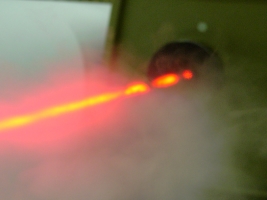Laser diffraction is most commonly applied for particle characterisation and particle size analysis. In laser diffraction (also called static light scattering or forward light scattering), the scattering pattern obtained from illumination of dispersed particles with a laser beam contains information about particle size and particle size distribution.
The interaction between particles and light is mainly dependent on particle size, shape, surface roughness and refractive indices of material and dispersing medium. For a specific material, the laser light scattering pattern of a particle is unique for its size. Deconvolution of the sample scattering pattern with an optical model such as Mie or Fraunhofer results in the particle size distribution.
The Fraunhofer model can adequately be used for particles larger than 10 µm, whereas for smaller particles the Mie model should be applied for accurate particle size information. The latter model also incorporates the optical properties of the solid particle, which become more important at smaller diameters.
The particle properties and particle size distribution can be assessed in a wide range from approx. 0.02 – 2000 µm for both dry dispersed particles or particles suspended in an aqueous or organic liquid medium. The laser diffraction particle size measurements are executed on a Coulter LS230 or a Malvern Mastersizer 2000 particle size analyser.




